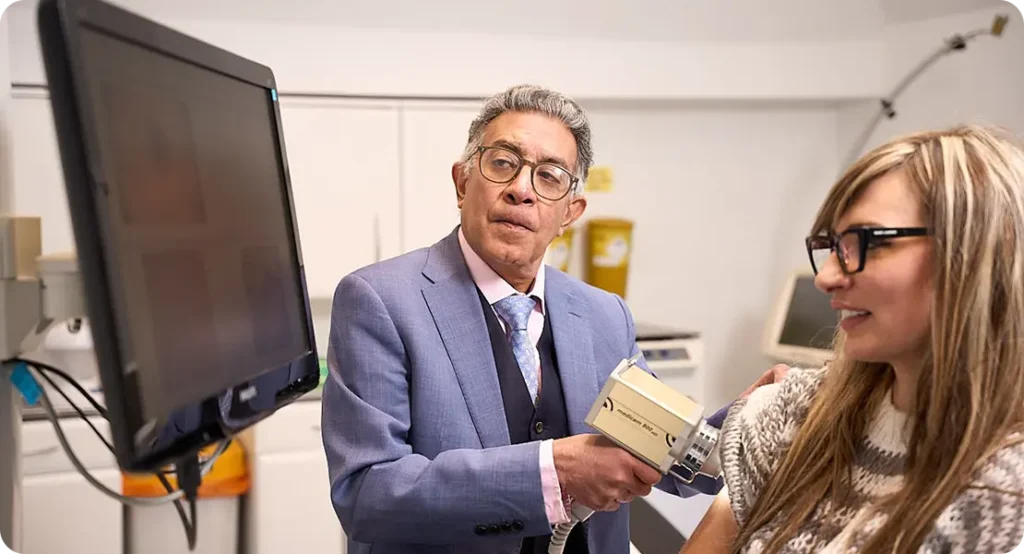Selecting the right private dermatologist in London is essential for effective skin care and treatment. Here’s a comprehensive guide to assist you in making an informed decision:
1. Understand Your Dermatological Needs
Begin by identifying your specific skin concerns. Dermatologists often specialise in areas such as medical dermatology (e.g., acne, eczema), cosmetic dermatology (e.g., anti-aging treatments), surgical dermatology (e.g., mole removal), or paediatric dermatology (for children’s skin issues). Clarifying your needs will help you select a dermatologist with the appropriate expertise.
Medical Dermatology
Medical dermatologists focus on diagnosing and treating a wide range of skin, hair, and nail disorders. They address conditions such as eczema, psoriasis, rosacea, shingles, warts, moles, excessive sweating, acne, autoimmune disorders, fungal infections, spider veins, melasma, and vitiligo. These specialists prioritise the overall health and well-being of patients, offering treatments like cryotherapy, lesion excision, vascular treatments, and prescription medications for chronic skin conditions.
Cosmetic Dermatology
Cosmetic dermatologists specialise in enhancing the appearance of the skin. They perform procedures such as Botox injections, fillers, laser hair removal, chemical peels, and skin tightening treatments. These professionals address aesthetic concerns, including signs of aging, uneven skin tone, and texture irregularities. It’s important to note that cosmetic procedures are typically elective and may not be covered by insurance.

Surgical Dermatology
Surgical dermatologists are trained to perform surgical procedures to treat both medical and cosmetic skin conditions. They often focus on the removal of skin cancers, cysts, and other growths. One specialised technique within this field is Mohs surgery, a precise method used to treat certain types of skin cancer by removing cancerous tissues while sparing as much healthy tissue as possible.
Paediatric Dermatology
Paediatric dermatologists specialise in diagnosing and treating skin conditions affecting children, from infancy through adolescence. They manage disorders such as birthmarks, eczema, warts, and genetic skin diseases, taking into account the unique needs of younger patients.
By understanding these various specialisations, you can better identify which type of dermatologist aligns with your specific needs, ensuring you receive the most appropriate care for your condition.
2. Verify Qualifications and Credentials
Ensuring that your dermatologist possesses the appropriate qualifications and credentials is crucial for receiving high-quality care. Here’s how you can assess these credentials:
General Medical Council (GMC) Registration
The General Medical Council (GMC) maintains the official register of medical practitioners in the UK. To practise medicine, a doctor must hold full registration with the GMC, indicating they have met the necessary educational and training standards.
Specialist Register
For specialist care, verify that your dermatologist is listed on the GMC’s Specialist Register. Introduced on 1 January 1997, this register includes doctors eligible for consultant posts in the NHS. Inclusion signifies completion of an approved specialist training programme or demonstration of equivalent qualifications and experience.
Certificate of Completion of Training (CCT)
A CCT is awarded to doctors who have successfully completed an approved UK training programme in a medical specialty. This certificate confirms that the doctor has met all competencies and standards set by the GMC and relevant Royal Colleges. Possession of a CCT is a prerequisite for entry onto the Specialist Register, underscoring the doctor’s dedication to their specialty.
Membership in Professional Bodies
Affiliation with esteemed professional organisations further attests to a dermatologist’s commitment to excellence:
- British Association of Dermatologists (BAD): Representing over 2,000 members, the BAD is dedicated to medical education, professional practice, and research in dermatology. Membership categories cater to various stages of medical careers, ensuring that members are continually engaged with advancements in dermatology.
- Royal College of Physicians (RCP): The RCP plays a pivotal role in setting and monitoring the standards of medical training. Membership indicates that a doctor has met rigorous standards and is committed to ongoing professional development.
- British Society for Dermatological Surgery (BSDS): Membership in the BSDS is open to physicians, surgeons, and nurses with an interest in dermatological surgery. Affiliation demonstrates a commitment to excellence in dermatological surgical procedures.

Continuing Professional Development (CPD)
Medicine is ever-evolving, and it’s vital that practitioners stay updated with the latest advancements. Engagement in CPD activities ensures that dermatologists maintain and enhance their knowledge and skills, reflecting a dedication to providing the best possible care.
Assessing a Dermatologist’s Credentials
When evaluating a dermatologist’s qualifications:
- Verify GMC Registration: Use the GMC’s online register to confirm that the dermatologist holds full registration and is listed on the Specialist Register in dermatology.
- Check Professional Memberships: Membership in reputable organisations like the BAD, RCP, or BSDS indicates adherence to high professional standards and a commitment to ongoing education.
- Review CPD Participation: Inquire about the dermatologist’s involvement in CPD activities, such as attending relevant conferences, workshops, or courses.
By thoroughly verifying these qualifications and credentials, you can be confident in selecting a dermatologist who is well-trained, experienced, and committed to maintaining the highest standards of care.
3. Assess Experience and Specialisations
Consider the dermatologist’s experience, particularly concerning your specific condition. An experienced dermatologist is more likely to provide accurate diagnoses and effective treatments. Some dermatologists may also have sub-specialties, such as dermal surgery or hair transplants, which could be relevant depending on your needs.
4. Seek Recommendations and Read Reviews
When searching for a dermatologist, leveraging personal recommendations and online reviews can significantly aid in making an informed decision. Here’s how you can effectively utilize these resources:
Personal Recommendations
Start by consulting individuals you trust, such as friends, family members, or your primary care physician. Personal referrals often lead to quality care, as they come from firsthand experiences. Inquire about specific aspects like the dermatologist’s communication style, the effectiveness of treatments, and overall satisfaction with the care provided. These insights can help you gauge whether a particular dermatologist aligns with your expectations.
Online Reviews and Testimonials
In addition to personal referrals, online reviews offer a broader perspective on a dermatologist’s practice. Websites such as healthgrades.com, ratemds.com, doctify,com, trustpiot.com and even the dermatologist’s Google business profile provide platforms where patients share their experiences. When evaluating online reviews, consider the following:
- Overall Rating: Look for dermatologists with consistently high ratings, as this often reflects a track record of patient satisfaction.
- Detailed Feedback: Focus on reviews that provide specific information about the treatments received, the professionalism of the staff, and the cleanliness of the facility. Detailed accounts offer a clearer picture of what to expect.
- Response to Criticism: Observe how the dermatologist or their office responds to negative reviews. A professional and constructive response indicates a commitment to patient care and continuous improvement.
5. Consider Accessibility and Location
When selecting a dermatologist in London, it’s crucial to consider the accessibility and location of the clinic to ensure that attending appointments is convenient and stress-free. Here’s how to evaluate these aspects effectively:
Proximity to Home or Workplace
Choosing a dermatologist near your home or workplace can significantly reduce travel time and make it easier to attend appointments, especially for ongoing treatments that require regular visits. A conveniently located clinic encourages adherence to treatment plans and reduces the likelihood of missed appointments.

Transportation Links
London’s extensive public transport network varies in accessibility across different areas. Consider the following when assessing a clinic’s location:
- Public Transport: Ensure the clinic is accessible via major public transport routes, such as the Underground, buses, or trains. This is particularly important if you rely on public transportation for commuting.
- Parking Facilities: If you drive, check for available parking options near the clinic. Some clinics may offer dedicated parking spaces or have nearby public parking facilities.
- Walking Distance: For clinics located in pedestrian-friendly areas, consider the walking distance from the nearest public transport stop to the clinic. This is especially pertinent if you have mobility concerns.
Clinic Hours and Appointment Availability
Aligning clinic hours with your personal schedule is essential for seamless appointment scheduling. Consider the following:
- Operating Hours: Check if the clinic offers appointments during early mornings, evenings, or weekends to accommodate your work or personal commitments.
- Appointment Flexibility: Some clinics may provide walk-in services or same-day appointments, which can be beneficial for urgent dermatological concerns.
By thoroughly considering accessibility and location factors, you can select a dermatologist in London whose clinic is conveniently situated and aligned with your scheduling needs, thereby facilitating consistent and effective dermatological care.
6. Evaluate Communication and Rapport
Establishing effective communication and a strong rapport with your dermatologist is fundamental to receiving optimal care. A positive doctor–patient relationship fosters trust, enhances treatment adherence, and contributes to better health outcomes. Here’s how to assess these aspects:
Importance of Effective Communication
Effective communication is the cornerstone of a successful doctor–patient relationship. It ensures that you feel heard, understood, and actively involved in your care decisions. During initial consultations, observe whether the dermatologist:
- Listens Attentively: A dermatologist who listens without interruption allows you to fully express your concerns, leading to a more accurate diagnosis and tailored treatment plan.
- Explains Clearly: Medical jargon can be confusing. A competent dermatologist should explain your condition and treatment options in plain language, ensuring you comprehend the information.
- Encourages Questions: An open dialogue is vital. Your dermatologist should invite questions and provide comprehensive answers, making you feel comfortable discussing any aspect of your care.

Building Rapport
Rapport goes beyond mere communication; it involves building a trusting and respectful relationship. A strong rapport can lead to increased patient satisfaction and better adherence to treatment plans. Consider the following indicators:
- Empathy and Compassion: A dermatologist who shows genuine concern for your well-being can make you feel valued and understood, fostering a therapeutic alliance.
- Professionalism and Respect: Mutual respect is crucial. Your dermatologist should respect your opinions, preferences, and cultural background, creating a safe and inclusive environment.
- Consistency and Reliability: Regular follow-ups and consistent care demonstrate the dermatologist’s commitment to your health, reinforcing trust in the relationship.
Patient-Centred Approach
A patient-centred approach ensures that your values, preferences, and needs guide all clinical decisions. This model of care has been associated with improved health outcomes and greater patient satisfaction. Key elements include:
- Shared Decision-Making: Your dermatologist should involve you in every step of the treatment process, discussing the risks and benefits of each option to help you make informed choices.
- Holistic Understanding: Beyond the immediate skin condition, a patient-centred dermatologist considers your overall well-being, including psychological and social factors that may impact your health.
Assessing During Consultation
During your consultation, reflect on the following:
- Comfort Level: Do you feel at ease discussing your concerns?
- Engagement: Is the dermatologist fully engaged, or do they seem distracted?
- Responsiveness: Does the dermatologist address your questions and concerns promptly and thoroughly?
Evaluating communication and rapport is a vital step in choosing the right dermatologist. A strong doctor–patient relationship not only enhances your healthcare experience but also contributes significantly to the effectiveness of your treatment.
7. Inquire About Treatment Techniques and Technology
Dermatology is a rapidly evolving field, with continuous advancements enhancing both diagnostic accuracy and treatment efficacy. When selecting a private dermatologist in London, it’s essential to inquire about the techniques and technologies they employ, as staying updated with the latest innovations can lead to more effective and tailored solutions for your skin concerns.

Advanced Diagnostic Tools
Modern diagnostic tools have revolutionised the early detection and management of various skin conditions:
- Dermatoscopy: This non-invasive imaging technique allows dermatologists to examine skin lesions with greater clarity, aiding in the early detection of conditions like melanoma.
- Mole Mapping: Advanced mole mapping systems digitally document moles and skin lesions, facilitating ongoing monitoring for any changes that may indicate malignancy.
Innovative Treatment Modalities
Contemporary dermatologists often employ a range of advanced treatment options:
- Laser Therapy: Utilised for various purposes, including skin resurfacing, hair removal, and the treatment of vascular lesions, laser therapy offers precision and reduced recovery times.
- Photodynamic Therapy (PDT): Combining light-sensitive agents with specific wavelengths of light, PDT effectively treats conditions like actinic keratosis and certain types of skin cancer with minimal invasiveness.
- Biologic Therapies: For chronic conditions such as psoriasis, biologic medications target specific components of the immune system, offering relief when traditional treatments have failed.
Commitment to Continuous Education
A dermatologist’s dedication to continuous education ensures they remain abreast of emerging treatments and best practices:
- Professional Development: Engagement in workshops, seminars, and conferences reflects a commitment to staying current with the latest advancements in dermatology.
- Research Contributions: Participation in clinical research or publication in peer-reviewed journals indicates a proactive approach to advancing the field.
8. Clarify Costs and Insurance Coverage
Navigating the financial aspects of private dermatological care is crucial to avoid unexpected expenses:
Understanding Fee Structures
Private dermatology consultations in London typically range from £220 to £400, depending on the practitioner’s experience and the complexity of the case. It’s essential to obtain a clear breakdown of potential costs:
- Consultation Fees: Confirm the cost of initial and follow-up consultations.
- Treatment Costs: Inquire about the prices of specific procedures or treatments you may require.
- Additional Expenses: Be aware of potential charges for diagnostic tests, laboratory work, or prescription medications.
Insurance Compatibility
If you possess private health insurance, it’s imperative to verify:
- Provider Recognition: Ensure the dermatologist is recognised by your insurance provider.
- Coverage Details: Understand which services are covered under your policy and any associated limitations
- Pre-authorisation Requirements: Some insurers necessitate pre-approval for specialist consultations or treatments.

Payment Plans and Financing
For services not covered by insurance, discuss:
- Payment Options: Some clinics offer payment plans or financing options to manage costs over time.
- Package Deals: Inquire about bundled services at a reduced rate, which may provide cost savings.
By thoroughly exploring treatment methodologies and financial considerations, you can make an informed decision when choosing a private dermatologist in London, ensuring both high-quality care and financial transparency.
9. Check Appointment Availability
Consider the dermatologist’s availability, especially if you require prompt attention. Some private practitioners may have limited hours, so ensure their schedule aligns with your needs. Timely appointments can be crucial for certain skin conditions.
Final Thoughts
Choosing a private dermatologist in London requires careful consideration of various factors, from qualifications and experience to accessibility and communication. By thoroughly evaluating these aspects, you can ensure that you receive personalised and effective care tailored to your specific skin concerns. Remember, investing time in selecting the right specialist is a vital step toward achieving optimal skin health.
If you’re seeking expert dermatological care, The London Dermatology Centre offers personalised treatments for a wide range of skin conditions. Our team of experienced specialists is dedicated to providing tailored solutions in a professional and caring environment.
Contact Information:
- Address: 69 Wimpole Street, London, W1G 8AS
- Phone: 0207 467 3720
- Email: reception@the-dermatology-centre.co.uk
Opening Hours:
- Monday to Friday: 9:00 AM – 5:30 PM
For more information or to schedule a consultation, please visit our website or contact us directly.
